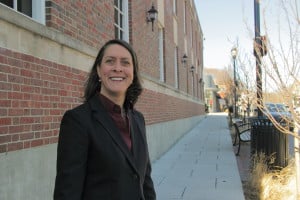Tanis Meakin
Title: Senior Vice President, Commercial Real Estate Lending, Belmont Savings Bank
Age: 47
Experience: 21 years
You might not immediately make the connection between commercial real estate and skiing, but Tanis Meakin does. Formerly a racer on the U.S. Women’s Ski Team, Meakin grew up in a family of bankers and joined the banking world in part because it combined her number-driven brain with her aversion to risk. In commercial real estate, like in skiing, Meakin gets to work with high-energy, focused and motivated people. She told Banker & Tradesman that that’s her favorite part of the job.
Q: You moved from Citizens Bank to Belmont Savings Bank, a much smaller institution. What was that transition like, and were you at all hesitant to make the jump to a community bank?
A: I moved here because a great team of executives moved from Citizens to Belmont. I was exceptionally leery of coming from a very well established, large institution to a small bank that, although it’s been around for 132 years, didn’t yet have a track record of working with the type of developers and customers that I’d been accustomed to.
The bank is 132 years old, but it’s invested in what it needs technology-wise to keep up with the larger banks and they have an exceptionally dedicated group of people. Between the technology, the respect and the people, we can punch way outside of our weight class. As a result, I’ve been able to do business with every customer I had at the big institution, and then some.
As an institution the balance sheet growth has been meaningful, but we haven’t really grown in people, so I feel that my contribution and every individual’s contribution is exceptionally meaningful. Sometimes you uncover great opportunities to take initiative, either fixing a process or implement a new idea without the same red tape you’d encounter in a big bank.
At one point in my career, I had done a lot of analytical work and I volunteered to take a stab at creating something that could measure risk with changing economic conditions. I built what we call a stress test model, and the stress test model is something that has now been rolled out and presented to the FDIC, the state of Massachusetts, all our regulators – [they] have roundly accepted [it] and now it’s shared with other small banks. That’s something I don’t think would happen as readily in a larger institution.
Q: What was your strategy for growing the CRE portfolio when you started at BSB in 2011?
A: When I came over, the market was not particularly strong. We were at the end of a recession and who knew how that would play out as a commercial real estate lender because a lot of things were pretty risky and a lot of banks didn’t want to take that risk. Belmont took the approach that there’s always good business to be done, so that was a great opportunity.
To come to a small bank, we weren’t stuck in an institutional quagmire. We made decisions quickly, predictably and timely for our customers and we were able to pick the low hanging fruit that wasn’t getting serviced the way it perhaps should have been. We truly did go looking for the best in breed who were not getting what they wanted otherwise. With that we built some great new relationships and continued to foster and grow those relationships, which mainly we’ve done by growing our balance sheet and increasing the amount of loans we can make to any one individual.
Q: Please share with B&T’s readers some of your thoughts about the market and your outlook for 2017.
A: The market feels like it’s slowing a little bit, but I would say I’m cautiously optimistic that it’s not slowing too much. I think in large part because overall, there’s a lot of uncertainty: what will happen with interest rates? Are we coming close to the end of the cycle? We’ve had a great real estate boom in Boston and there’s a lot of construction and development going on and a lot of properties changing hands. But when you’re not sure what’s going to happen with interest rates it’s harder to make a buy decision, because frankly, if interest rates go up, values sometimes come down, so why would you buy something today that might not be worth the same thing tomorrow?
We look at everything on a deal-by-deal basis. It’s all based on cash flow. There’s always an opportunity for lenders in commercial real estate; the tenure of a deal is 10 years or less, so deals are always coming out of one product and ready to roll into another, or be refinanced. There’s always opportunity for us. I don’t see that the volume we’ll do will be as active, but perhaps it will be more consistent.
In other words, we did a tremendous amount of volume here. I had my personal best year ever with over $100 million in business, but there was a lot of churn. Developers would come, they’d finance something and within months they’d sell it and it would roll it out of the portfolio – because there was a lot of opportunity. Now I feel like the deals we’re doing will stay on the books and we won’t have as much churn.
Meakin’s Top Five Skiing Destinations:
- La Plagne, France
- Beaver Creek, Colorado
- Portillo, Chile
- Lech-Zürs, Austria
- Nagano, Japan




 |
| 

